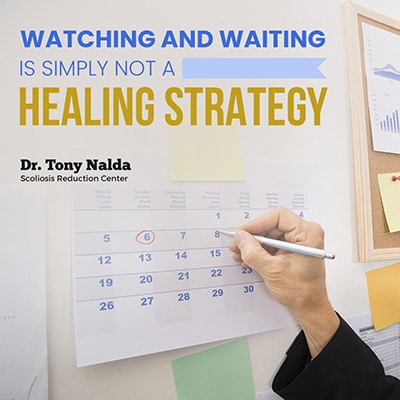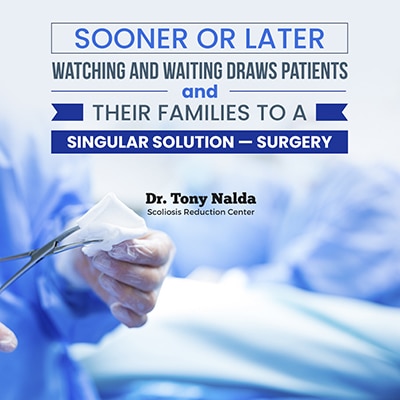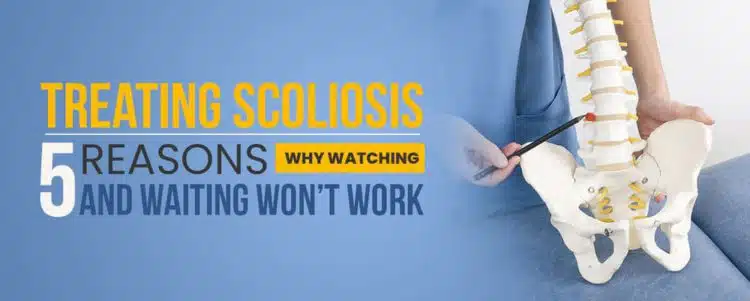
The traditional approach to treating scoliosis is conservative and seemingly sensible. Experts in the realm of conventional treatment agree that the best approach is to watch and wait. They err on the side of being reactive instead of proactive, and they convince patients and their families that their methods are practical, rational and grounded in the most modern best practices. But all the watching and waiting that’s done by scoliosis patients never improves the condition. In most cases, watching and waiting means watching as a spinal curvature progresses, and then waiting to undergo expensive and invasive surgery.
Fortunately, alternative approaches to scoliosis treatment are gaining credibility and popularity. Here at the Scoliosis Reduction Center®, we take a decidedly proactive approach to treating the condition. And we see people every single day for whom the traditional, “watch and wait” method is just not good enough.
With our chiropractic-centered treatment, patients feel like they are in the driver’s seat. They are encouraged to be active and to engage in treatments that actually reduce spinal curvatures and help them avoid surgery. Our results speak for themselves — patients not only find relief for the physical aspects of scoliosis; they find that our approach allows them to feel a significant mental and emotional boost. Instead of watching and waiting, they are taking charge of their condition and engaging in treatment that gives them the chance to live their best lives.
And yet, the traditional “watch and wait” approach continues to reign supreme.
If you or your child are dealing with a scoliosis diagnosis, you may feel like you are stuck between a rock and a hard place. On one hand, you have the experts who recommend the watch-and-wait approach to treatment. On the other hand, you feel a need to be more proactive with the condition, which is what the experts seem to discourage.
Watching and waiting seems sensible, and it has the backing of orthopedic surgeons and other experts, but there’s a lot those experts won’t tell you.
Here are seven reasons why watching and waiting won’t work when it comes to treating scoliosis:
#1 — It Does Not Stop the Progression of Abnormal Spinal Curvatures
I cannot be more explicit about this. Watching and waiting is simply not a healing strategy. If watching and waiting ever resulted in a reduced — or even static — curvature, it would be absolutely remarkable. But the fact is that this approach will never yield positive results. The nature of untreated scoliosis is to continue its progression. So when you fail to be proactive in treatment, the condition is allowed to continue progressing over time. And guess what? Eventually, it will progress to the point where surgery presents itself as the only viable option for relief. And even then, surgery is not guaranteed to stop the progression of the curvature, much less reverse it. But it is guaranteed to cost a lot of money.
#2 — It Leaves Patients and Family Members Feeling Powerless
Most people, when faced with a challenge or a medical diagnosis, feel compelled to do something to overcome it. And for most conditions or illnesses, patients and their families are empowered with options and potential actions. When your child scrapes their knee or suffers a playground injury, there is no watching and waiting! You take action and participate in the healing of the condition. But when it comes to scoliosis treatment, watching and waiting is presented as the best option, in many cases. This leaves patients and family member feeling as if they have no agency or ability to take action. Instead, they must bide their time and pray for an unprecedented improvement.
#3 — It Represents a Huge Missed Opportunity
When a patient is told to wait six months after their diagnosis to come back for another examination, that’s six months during which they could be actively addressing their condition. Instead, they are directed to sit still and watch the days on the calendar float by. Inevitably, when they come back to the doctor, their curve has progressed. At this point, discussion of next steps involves talk of surgery.
All the time spent watching and waiting could have been used as an opportunity to address the condition directly through a chiropractic-centered treatment program. Treatment is most effective when curves are less severe. Smaller curvatures are much more manageable, and potential outcomes are far more favorable when the condition is treated as early as possible.
#4 — It Almost Always Leads to Surgery

Sooner or later, watching and waiting draws patients and their families to a singular solution — surgery. Of course, surgeons see surgery as the most effective solution because that is their specialty. If they recommended more proactive, less invasive approaches, they might not be able to stay in business. It reminds me of the old saying, “when your only tool is a hammer, every problem looks like a nail.”
What’s more, surgery cannot be considered a “cure” for the condition. Yes, it may stabilize the spine and prevent continued progression, but it does nothing to address the underlying cause or causes of scoliosis. It can also introduce new problems. For example, spinal fusion surgery involves the removal of spinal discs that are responsible for cushioning the spine from impact. Without them, the body (and the surgically implanted rods) must absorb shock and impact, leading to further potential complications and injury.
#5 — It Can Make Patients and Family Members Feel Hopeless
Hope may be an intangible quality that’s impossible to measure, but it’s incredibly powerful when facing an illness or a condition like scoliosis. Hope is what gets people through their toughest times, and it can have a considerable impact on overall well-being. However, when patients and parents are told to watch and wait for a curvature progression to reach a certain level so surgery can be performed, it removes hope from the equation entirely.
Hope is essential for healing, but it gets pushed to the margins when taking the watch-and-wait approach to scoliosis treatment. Thankfully, you don’t have to just bide your time and observe. You can be hopeful, and you can be proactive. Our approach here at the Scoliosis Reduction Center® builds confidence, creates measurable improvements, helps patients avoid surgery and, importantly, restores hope.





